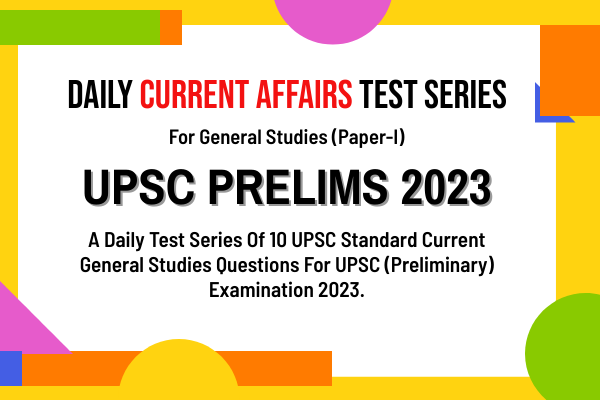Daily UPSC Prelims Current Affairs – May 27, 2022 [Mock Test]
May 27, 2022 May 27, 2022
1. Which of the following doctrines promotes regionalism?
[A] Son of the Soil principle
[B] Principle of Natural justice
[C] Principle of Subsidiarity
[D] Principle of Non-refoulement
[B] Principle of Natural justice
[C] Principle of Subsidiarity
[D] Principle of Non-refoulement
Correct Answer: A [Son of the Soil principle]
Notes:
- Son of the soil doctrine according to which, a state specifically belongs to the native group only, who are the sons of the soil or local residents. The doctrine gains currency due to competition for job and resources between migrant and local educated middle-class youth. For ex: Maharashtra for Marathas, Gujrat for gujratis etc. It is a kind of regionalism that views a state as specifically belonging to the main linguistic group inhabiting it.
- Natural justice implies fairness, reasonableness, equity and equality. Indian Constitution does not use the expression ‘Natural Justice’ anywhere. However, the parts of the Constitution with their respective expressions convey the idea of Natural Justice. For example, in India the principles of natural justice are firmly grounded in Article 14 and 21 of the Constitution.
- The principle of subsidiarity stipulates that the functions of administration shall be carried at the smallest unit of governance possible and delegated upwards only when the local unit cannot perform the task.
- Non-refoulement is a fundamental principle of international law that forbids a country receiving asylum seekers from returning them to a country in which they would be in likely danger of persecution based on “race, religion, nationality, membership of a particular social group or political opinion”. It means a person fleeing from persecution from his own country should not be forced to return.
2. Consider the following statements on recently signed India-UAE CEPA (Comprehensive Economic Partnership Agreement):
- Market access and regulatory approval within 90 days for Indian pharmaceutical products and medical products.
- An MOU on Food Security Corridor Initiative.
- An MOU between India’s Gift City and Abu Dhabi Global Market.
Which of the statements given above are correct?
[A] Only 1 & 2
[B] Only 2 & 3
[C] Only 1 & 3
[D] 1, 2 & 3
[B] Only 2 & 3
[C] Only 1 & 3
[D] 1, 2 & 3
Correct Answer: D [1, 2 & 3]
Notes:
- Recently, India and United Arab Emirate (UAE) signed India-UAE CEPA (Comprehensive Economic Partnership Agreement). CEPA provides for an institutional mechanism to encourage and improve trade between the two countries.
- India-UAE FTA is set to reduce tariffs for 80 per cent of goods and give zero-duty access to 90 per cent of India’s exports to the UAE. Currently it attracts a 5-per cent import duty in the UAE are set to benefit.
- India-UAE CEPA includes robust rules of origin to protect both economies from misuse of the agreement by third countries, including a requirement of “melt and pour” for steel exports to qualify as domestically produced products from either country.
- The agreement also provides a permanent safeguard mechanism to protect businesses in both countries to prevent “any unnecessary or unwarranted surge in volumes of (imports) any particular product
- Under the India-UAE CEPA, the UAE agreed to facilitate market access and regulatory approval within 90 days for Indian pharmaceutical products and medical products.
- The two Leaders also released Joint Commemorative Stamp on the occasion of 75thanniversary of India’s independence and 50th year of UAE’s foundation. Two MOUs signed between Indian and UAE entities were also announced during the Summit. These are, MOU between APEDA and DP World & Al Dahra on Food Security Corridor Initiative and MOU between India’s Gift City and Abu Dhabi Global Market on cooperation in financial projects and services. Two other MOUs – one on cooperation in Climate Action and the other on Education have also been agreed between the two sides.
3. According to which of the following theories, “the Earth is a self-controlled, harmonic, and interactive complex of biological and nonbiological worlds on the planet”?
[A] Nebular Hypothesis
[B] Core Accretion Theory
[C] Disk instability Theory
[D] Gaia Theory
[B] Core Accretion Theory
[C] Disk instability Theory
[D] Gaia Theory
Correct Answer: D [Gaia Theory]
Notes:
- The Gaia hypothesis proposes that living organisms interact with their inorganic surroundings on Earth to form a synergistic and self-regulating, complex system that helps to maintain and perpetuate the conditions for life on the planet.
- Nebular hypothesis posits that, 4.6 billion years ago, the Solar System was formed by the gravitational collapse of a giant molecular cloud spanning several light-years.
- The core accretion theory suggested that before the formation of the Earth, the solar system was a cloud of dust and gas known as solar nebula. Due to gravity, the materials were collapsed in on themselves as it began to spin, which formed the sun in the centre of the nebula. Small particles bound into large particles by gravity. The solar wind swept away lighter elements leaving heavy rocky materials to create terrestrial world. With heavy elements colliding and binding together, Earth’s rocky core formed first. Dense material sank to the centre and the lighter pieces created the crust. Gravity captured some of the lighter elements that make up the planet’s early atmosphere.
- Disk instability model suggested that clumps of dust and gas are bound together early in the life of solar system. These clumps slowly compact into a giant planet. These planets can form faster than their core accretion rivals, allowing them to trap the rapidly-vanishing lighter gases.


